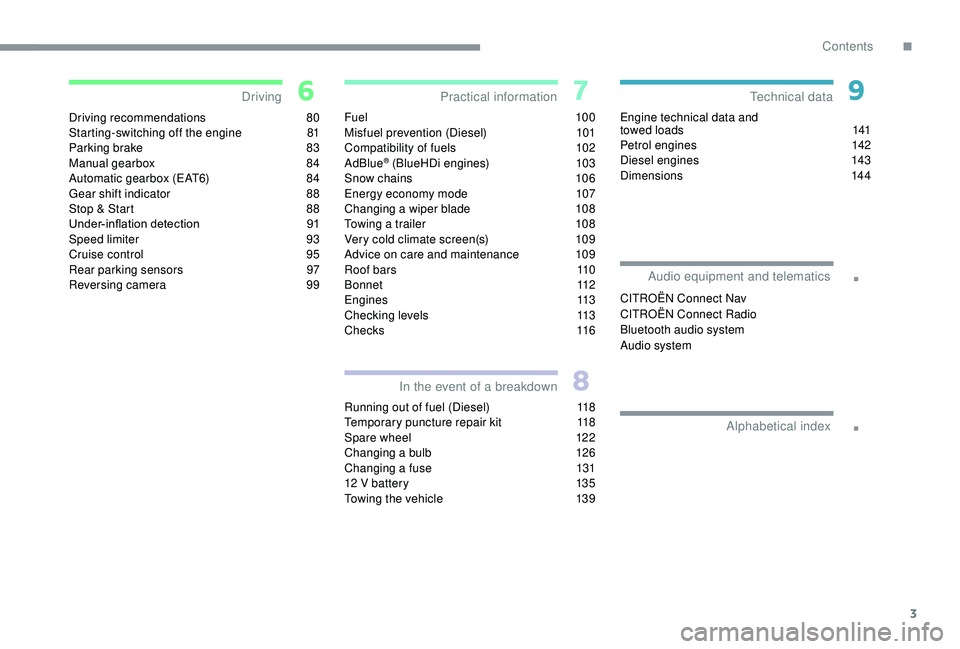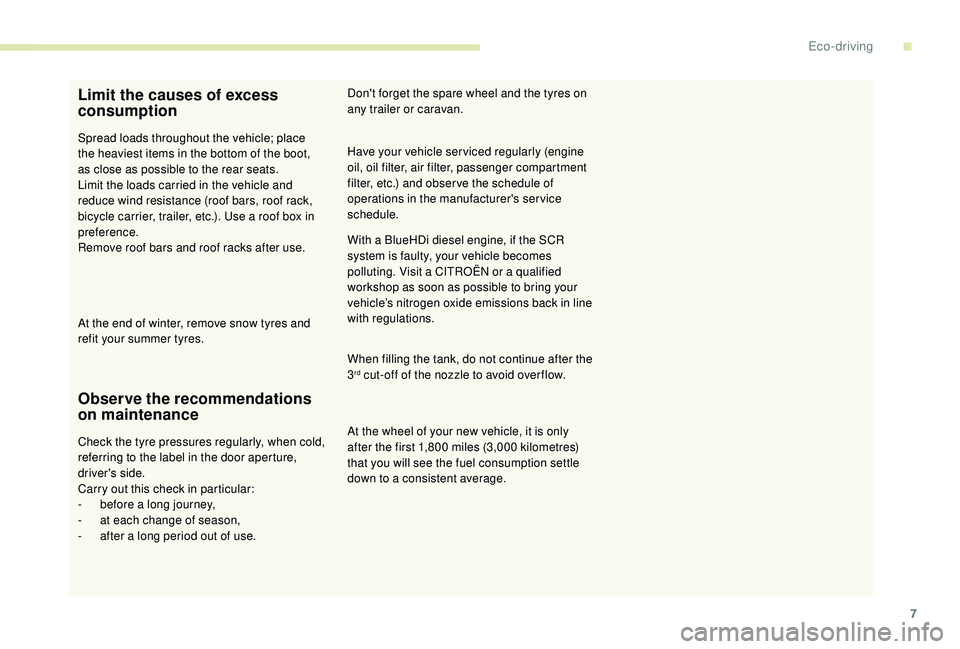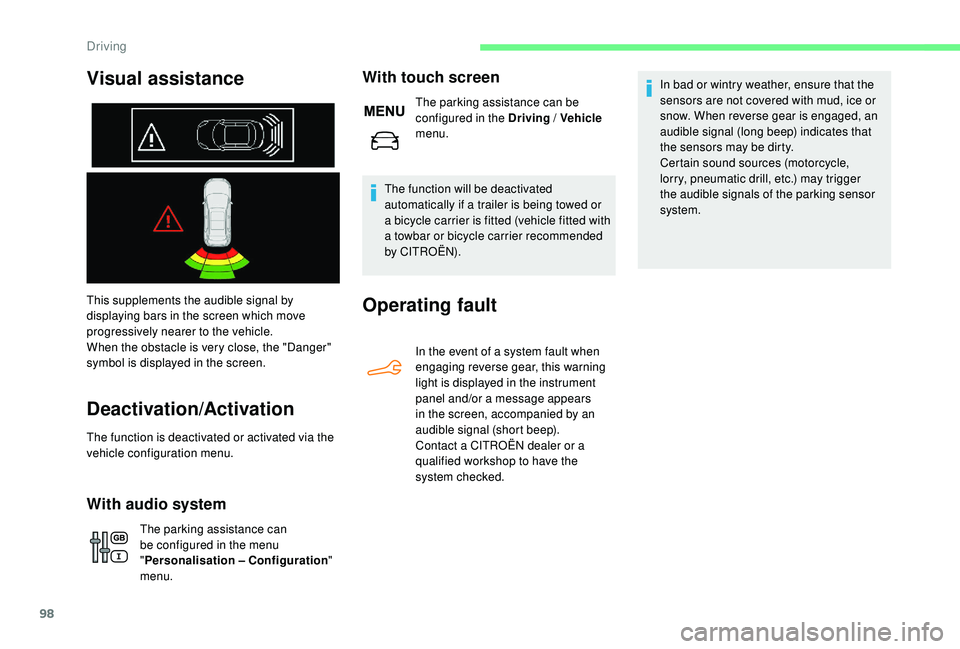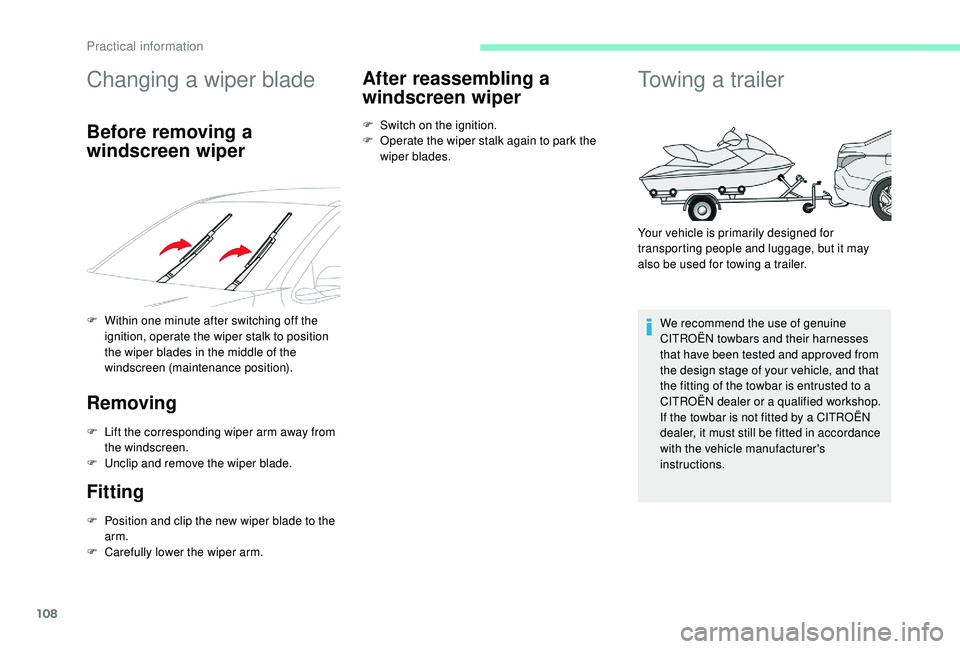trailer CITROEN C-ELYSÉE 2022 Handbook (in English)
[x] Cancel search | Manufacturer: CITROEN, Model Year: 2022, Model line: C-ELYSÉE, Model: CITROEN C-ELYSÉE 2022Pages: 260, PDF Size: 8.4 MB
Page 5 of 260

3
.
.
Driving recommendations 80
Starting-switching off the engine 8 1
Parking brake
8
3
Manual gearbox
8
4
Automatic gearbox (EAT6)
8
4
Gear shift indicator
8
8
Stop & Start
8
8
Under-inflation detection
9
1
Speed limiter
9
3
Cruise control
9
5
Rear parking sensors
9
7
Reversing camera
9
9Fuel 1
0 0
Misfuel prevention (Diesel) 1 01
Compatibility of fuels
1
02
AdBlue
® (BlueHDi engines) 1 03
Snow chains 1 06
Energy economy mode
1
07
Changing a wiper blade
1
08
Towing a trailer
1
08
Very cold climate screen(s)
1
09
Advice on care and maintenance
1
09
Roof bars
1
10
B o n n e t
112
Engines
1
13
Checking levels
1
13
C h e c k s
11
6
Running out of fuel (Diesel)
1
18
Temporary puncture repair kit
1
18
Spare wheel
1
22
Changing a bulb
1
26
Changing a fuse
1
31
12
V battery
1
35
Towing the vehicle
1
39Engine technical data and
towed loads
1
41
Petrol engines
1
42
Diesel engines 1 43
Dimensions 144
DrivingPractical information
In the event of a breakdown Technical data
Alphabetical index
Audio equipment and telematics
CITROËN Connect Nav
CITROËN Connect Radio
Bluetooth audio system
Audio system
.
Contents
Page 9 of 260

7
Limit the causes of excess
consumption
Spread loads throughout the vehicle; place
the heaviest items in the bottom of the boot,
as close as possible to the rear seats.
Limit the loads carried in the vehicle and
reduce wind resistance (roof bars, roof rack,
bicycle carrier, trailer, etc.). Use a roof box in
preference.
Remove roof bars and roof racks after use.
At the end of winter, remove snow tyres and
refit your summer tyres.
Observe the recommendations
on maintenance
Check the tyre pressures regularly, when cold,
referring to the label in the door aperture,
driver's side.
Carry out this check in particular:
-
b
efore a long journey,
-
a
t each change of season,
-
a
fter a long period out of use. Have your vehicle ser viced regularly (engine
oil, oil filter, air filter, passenger compartment
filter, etc.) and obser ve the schedule of
operations in the manufacturer's service
schedule. Don't forget the spare wheel and the tyres on
any trailer or caravan.
With a BlueHDi diesel engine, if the SCR
system is faulty, your vehicle becomes
polluting. Visit a CITROËN or a qualified
workshop as soon as possible to bring your
vehicle’s nitrogen oxide emissions back in line
with regulations.
When filling the tank, do not continue after the
3
rd cut-off of the nozzle to avoid over flow.
At the wheel of your new vehicle, it is only
after the first 1,800
miles (3,000 kilometres)
that you will see the fuel consumption settle
down to a consistent average.
.
Eco-driving
Page 100 of 260

98
This supplements the audible signal by
displaying bars in the screen which move
progressively nearer to the vehicle.
When the obstacle is very close, the "Danger"
symbol is displayed in the screen.
Deactivation/Activation
The function is deactivated or activated via the
vehicle configuration menu.
With audio system
The parking assistance can
be configured in the menu
"Personalisation – Configuration "
menu.
With touch screen
The parking assistance can be
configured in the Driving / Vehicle
menu.
The function will be deactivated
automatically if a trailer is being towed or
a bicycle carrier is fitted (vehicle fitted with
a towbar or bicycle carrier recommended
by CITROËN).
Operating fault
In the event of a system fault when
engaging reverse gear, this warning
light is displayed in the instrument
panel and/or a message appears
in the screen, accompanied by an
audible signal (short beep).
Contact a CITROËN dealer or a
qualified workshop to have the
system checked. In bad or wintry weather, ensure that the
sensors are not covered with mud, ice or
snow. When reverse gear is engaged, an
audible signal (long beep) indicates that
the sensors may be dirty.
Certain sound sources (motorcycle,
lorry, pneumatic drill, etc.) may trigger
the audible signals of the parking sensor
system.
Visual assistance
Driving
Page 110 of 260

108
Changing a wiper blade
Before removing a
windscreen wiper
F Within one minute after switching off the ignition, operate the wiper stalk to position
the wiper blades in the middle of the
windscreen (maintenance position).
Removing
F Lift the corresponding wiper arm away from the windscreen.
F
U
nclip and remove the wiper blade.
Fitting
F Position and clip the new wiper blade to the arm.
F
C
arefully lower the wiper arm.
After reassembling a
windscreen wiper
F Switch on the ignition.
F O perate the wiper stalk again to park the
wiper blades.
Towing a trailer
Your vehicle is primarily designed for
transporting people and luggage, but it may
also be used for towing a trailer.
We recommend the use of genuine
CITROËN towbars and their harnesses
that have been tested and approved from
the design stage of your vehicle, and that
the fitting of the towbar is entrusted to a
CITROËN dealer or a qualified workshop.
If the towbar is not fitted by a CITROËN
dealer, it must still be fitted in accordance
with the vehicle manufacturer's
instructions.
Practical information
Page 111 of 260

109
Driving with a trailer places greater
demands on the towing vehicle and the
driver must take particular care.
For more information on Driving
recommendations, particularly when
towing, refer to the corresponding section.
Please observe the maximum authorised
towed weights, indicated on the
registration certificate or in your vehicle’s
technical data.
For more information on Weights (and the
towed loads which apply to your vehicle)
refer to the corresponding section.
Obser ve the legislation in force in the
country in which you are driving.Very cold climate
screen(s)
(Depending on the country of sale.)
Removable screen(s) which prevent snow
accumulating at the radiator cooling fan.
Depending on the version, you have one or two
screens.
Before fitting or removing a screen,
ensure that the engine is off and the
cooling fan has stopped.
Fitting
F Place the very cold climate screen in front of the front bumper.
F
P
ress around its edge to engage its fixing
clips one by one.
Removing
F Use a screwdriver as a lever to release each of the fixings of each screen in turn.
It is essential to remove the very cold
climate screen (or screens) in case of:
-
w
hen the exterior temperature exceeds
10°C,
-
w
hen towing,
-
a
t speeds above 75 mph (120 km/h).
Advice on care and
maintenance
Recommendations on the care and
maintenance of your vehicle are given in the
Maintenance and Warranty Guide.
7
Practical information
Page 136 of 260

134
Fuses in the engine
compartment
The fusebox is located in the engine
compartment near the battery (left-hand side).
Access to the fusesFuse N°Rating Functions
F29 -Not used.
F30 10
AHeated door mirrors.
F31 25
AHeated rear screen.
F32 -Not used.
F33 30
AFront electric windows.
F34 30
ARear electric windows.
F35 30
AHeated front seats.
F36 -Not used.
F37 20
ATrailer inter face box. F
U
nclip the cover.
F
C
hange the fuse.
F
W
hen you have finished, close the cover
very carefully to ensure correct sealing of
the fusebox.
In the event of a breakdown
Page 143 of 260

141
Engine technical data and
towed loads
Engines
The engine technical data are indicated in the
vehicle's registration document, as well as in
sales brochures.The maximum power corresponds to the
value type-approved on a test bed, under
conditions defined in European legislation
(Directive 1999/99/EC).
For more information, contact a CITROËN
dealer or a qualified workshop.
Weights and towed loads
The maximum weights and towed loads for
your vehicle are indicated in the registration
document, as well as in sales brochures.
These values are also indicated on the
manufacturer's plate or label.
For more information, contact a CITROËN
dealer or a qualified workshop. The GTW values and the towed loads listed are
valid for a maximum altitude of 1,000
metres.
The towed load must be reduced by steps of
10% for each additional 1,000 metres.
The recommended nose weight is the vertical
load on the towbar ball (removable, with or
without tools).
GT W: Gross train weight.
High exterior temperatures may result
in a reduction in the per formance of the
vehicle to protect the engine. When the
exterior temperature is higher than 37°C,
limit the towed weight.
Towing using a lightly loaded vehicle can
adversely affect roadholding.
Braking distances are increased when
towing a trailer.
When using a vehicle to tow, never exceed
a speed of 60 mph (100 km/h) (obser ve
the local legislation in force). If the exterior temperature is high, it is
recommended that the engine be allowed
to idle for 1
to 2 minutes after the vehicle
comes to a stop, to facilitate its cooling.
9
Technical data
Page 144 of 260

142
Petrol engines and towed
loads
EnginePureTech 82V T i 115
Gearboxes Manual 5-speed
(BVM5) Manual 5-speed
(BVM5) Automatic 6-speed
( E AT 6)
Code EB2FEC5F
Model code: DD, etc. HMZ6NFP0
NFP6NFPT
Cubic capacity (cm
3) 1,1 9 9 1,5 87
Max power: EU standard (kW) 6085
Fuel Unleaded 91
RON to 98 RONUnleaded 91
RON to 98 RON
Braked trailer (within the GTW limit)
on a 10% or 12% gradient (kg) 450
750
Unbraked trailer (kg) 450580
Recommended nose or ball joint weight (kg)
or trailer nose weight 55
55
Technical data
Page 145 of 260

143
Diesel engines and towed
loads
EngineHDi 92BlueHDi 100
Gearboxes Manual 5-speed
(BVM5) Manual 5-speed
(BVM5)
Code DV6DTEDDV6TEDDV6FD
Model code: DD, etc. 9HJC9HP0BHY6
Cubic capacity (cm
3) 1,5 6 01,5 6 0
Max power: EU standard (kW) 6873
Fuel DieselDiesel
Braked trailer (within the GTW limit)
on a 10% or 12% gradient (kg) 750
750
Unbraked trailer (kg) 580580
Recommended nose or ball joint weight (kg)
or trailer nose weight 55
55
9
Technical data